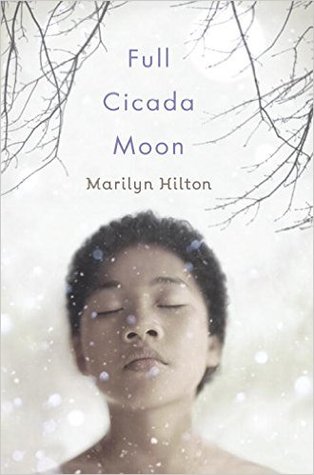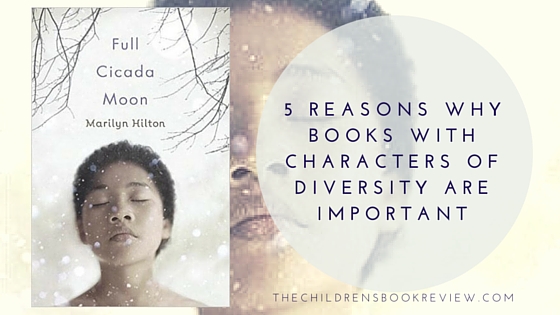Marilyn Hilton | The Children’s Book Review | October 23, 2015
Why We Need to Tell the Whole Story
When I was growing up, I could often be found checking out another book from the library about Ramona and her friends or in my room reading another Nancy Drew mystery. I devoured books, and reading planted the desire in me to one day write books for other kids to read. Most, if not all, the books I read starred and featured characters who looked like me, an American girl of English and Scots descent. No matter what adventures the characters went on, I could identify with their traditions and family backgrounds, and comfortably joined their adventures within the context of my own life.
My husband, however, whose mom is Japanese and whose dad is African American, had a different reading experience as a child. He can’t recall one book he read with a character who looked like him or shared his family heritage. So he could not identify easily with the characters he read about and was unable to share the same comfortable familiarity with them. While I was included in the story adventures, he felt more like an observer.
Because he and kids like him didn’t have books that starred kids like them, I wrote the middle-grade novel Full Cicada Moon, narrated by Mimi Oliver, a girl of mixed race, so that my children and others like them might see themselves in her story. If readers could get to know Mimi, they would either see themselves in her story or understand her experience and perspective.
This book is just one in a growing list of books that feature characters of diversity. Here are some reasons why these books are so important.
Because kids need to see themselves reflected in the books they read
Just as the books I read influenced my dreams of one day becoming a writer, books about other kids—and men and women—of all colors, backgrounds, faiths, and orientations need to be available in order to shape the dreams of today’s readers. If children can’t see themselves in the books they read, or if they can’t find heroes who were like them as children, their dreams may never have the opportunity to form.
Because kids need to walk in others’ shoes
Seeing the world from another point of view fosters understanding, understanding creates empathy, and empathy closes the gap of fear and indifference. The more stories we offer kids that feature diverse characters, the greater their empathy will become. It’s human nature to be disengaged from what doesn’t affect us personally. But when we can walk in the shoes of characters whose lives are different from ours, their experiences affect us, their stories influence our perspective, and their lives matter to us. Their stories become part of our story, and that changes us.
Because the world is shrinking rapidly and its future depends on our kids
If any generation is to turn the idea of peace among nations into reality, it will be our children’s. As a society, we can no longer live in isolation. We have to virtually eat at one another’s tables, learn one another’s languages, and sleep in one another’s tents. And as technologies evolve and borders vanish, a hopeful future depends on our children’s curiosity and their ability to embrace other cultures and traditions. This begins in our homes, schools, and neighborhoods and extends outward.
Because diversity is everyone’s story
We do not exist alone but in community with others. Who we are, what we look like, where our ancestors came from, what faith we practice, or language we speak, or what gender we identify with and whom we love are not only our individual stories; they’re collectively the story of humankind, which brought us to the place at this moment. Our stories have been woven into the fabric of our families, our histories, and the human experience since the beginning of time. We are connected to one another by rich and profound threads, and we are all responsible for creating and ensuring that everyone has a voice and a safe place in which to tell their stories—our stories.
How we can promote and encourage diversity in children’s literature
The cry for books offering diverse perspectives has grown into a powerful movement, which, thankfully, is being heard and answered. But we as authors, publishers, parents, and educators must keep this movement growing. Let’s write stories that star characters of all cultures, backgrounds, faiths, and genders. Let’s grow lists of stories about diversity. Let’s buy and request these books, and talk about them at home, at school and in our libraries, and on social media and other public places. And let’s all tell others about the books we love. Because the more wonderful books about our diversity that we talk about, the more great books about our diversity will be published.
I’m optimistic that, through literature that explores and celebrates diversity, all kids will be able to comfortably go on any adventure with any character to anywhere.
About Marilyn Hilton
Marilyn Hilton is the author of the novels Full Cicada Moon and Found Things and two nonfiction books for children. She lives with her family in northern California.
 Full Cicada Moon
Full Cicada Moon
Written by Marilyn Hilton
Publisher’s Synopsis: Inside Out and Back Again meets One Crazy Summer and Brown Girl Dreaming in this novel-in-verse about fitting in and standing up for what’s right.
It’s 1969, and the Apollo 11 mission is getting ready to go to the moon. But for half-black, half-Japanese Mimi, moving to a predominantly white Vermont town is enough to make her feel alien. Suddenly, Mimi’s appearance is all anyone notices. She struggles to fit in with her classmates, even as she fights for her right to stand out by entering science competitions and joining Shop Class instead of Home Ec. And even though teachers and neighbors balk at her mixed-race family and her refusals to conform, Mimi’s dreams of becoming an astronaut never fade—no matter how many times she’s told no.
This historical middle-grade novel is told in poems from Mimi’s perspective over the course of one year in her new town, and shows readers that positive change can start with just one person speaking up.
Ages 8-12 | Publisher: Dial Books | 2015 | ISBN-13: 978-0525428756
Available Here:
Mariyln Hilton, author of Full Cicada Moon, wrote this article: 5 Reasons Why Books with Characters of Diversity Are Important. Discover more articles on The Children’s Book Review tagged with Books Set in the 1960s, African American, Diversity, Middle Grade Books, Cultural Wisdom, and Quest for Literacy.


2 Comments
Seeing myself in book characters got me through some difficult times in my childhood. It’s so important for kids to be able to find a character they can relate to. It’s equally important for children to be able to imagine different experiences through characters who are different than them. I’m excited to read Full Cicada Moon.
Pingback: Full Cicada Moon | Book Discussion Guides